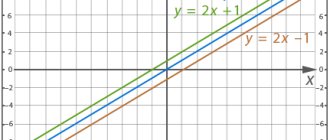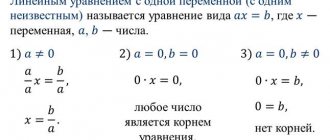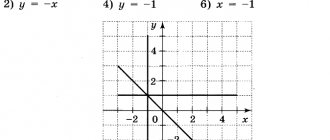November 12, 2017
- Homework
- Answers
First, a little lyrics to get a feel for the problem that the interval method solves. Let's say we need to solve the following inequality:
(x − 5)(x + 3) > 0
What are the options? The first thing that comes to mind for most students is the rules “plus on plus gives plus” and “minus on minus gives plus.” Therefore, it is enough to consider the case when both brackets are positive: x − 5 > 0 and x + 3 > 0. Then we also consider the case when both brackets are negative: x − 5 < 0 and x + 3 < 0. Thus, our inequality is reduced to a combination of two systems, which, however, is easily solved:
More advanced students will (maybe) remember that on the left is a quadratic function whose graph is a parabola. Moreover, this parabola intersects the OX axis at points x = 5 and x = −3. For further work, you need to open the brackets. We have:
x2 − 2x − 15 > 0
Now it is clear that the branches of the parabola are directed upward, because coefficient a = 1 > 0. Let's try to draw a diagram of this parabola:
The function is greater than zero where it passes above the OX axis. In our case, these are the intervals (−∞ −3) and (5; +∞) - this is the answer.
Please note: the figure shows exactly the diagram of the function , not its graph. Because for a real graph you need to count coordinates, calculate displacements and other crap that we have absolutely no use for now.
Why are these methods ineffective?
So, we have considered two solutions to the same inequality. Both of them turned out to be quite cumbersome. The first decision arises - just think about it! — a set of systems of inequalities. The second solution is also not particularly easy: you need to remember the graph of the parabola and a bunch of other small facts.
It was a very simple inequality. It only has 2 multipliers. Now imagine that there will be not 2, but at least 4 multipliers. For example:
(x − 7)(x − 1)(x + 4)(x + 9) < 0
How to solve such inequality? Go through all possible combinations of pros and cons? Yes, we will fall asleep faster than we find a solution. Drawing a graph is also not an option, since it is not clear how such a function behaves on the coordinate plane.
For such inequalities, a special solution algorithm is needed, which we will consider today.
Rational inequalities. Interval method
Generalization of the interval method for integer rational inequalities of any degree
In the general case, in the whole rational inequality on the left there is a polynomial of degree n:
$$ P_n (x) = a_n x^n+a_{n-1} x^{n-1}+⋯+a_1 x+a_0 $$
where x is a variable, $a_i \in \Bbb, i = \overline{0,n} $ are some real numbers, and $a_n \neq 0$.
The root of a polynomial $P_n (x)$ is a real number c such that when substituted, $P_n (c)$ = 0.
For example:
Consider a 2nd degree polynomial: $P_2 (x) = x^2+5x+6$
x = -3 is its root, because $P_2 (-3) = (-3)^2+5 \cdot (-3)+6 = 0$
x = -2 is its root, because $P_2 (-2) = (-2)^2+5 \cdot (-2)+6 = 0$
In this case: $P_2 (x) = (x+3)(x+2)$
If c is the root of the polynomial $P_n (x)$, then the polynomial is divisible by (xc) without remainder.
CASE 1. Linear factors to the 1st power
Let the polynomial $P_n (x)$ have n different roots $c_i,i = \overline{1,n}$. Then it can be represented as a product:
$$ P_n (x) = (x-c_1 )(x-c_2 )…(x-c_n ) $$
Algorithm for solving the inequality $(x-c_1 )(x-c_2 )…(x-c_n ) \gt 0$ using the interval method
For definiteness, let $c_1 \lt c_2 \lt ⋯ \lt c_n$. This can always be achieved, because... The product does not change when the factors are rearranged.
Step 1.
Mark the roots $c_1,c_2,…c_n$ on the number line. Because the inequality is strict, the points must be “white”. The number line will be divided into n+1 regions:
1) to the left of $c_1$; 2) between $c_1$ and $c_2$; 3) between $c_2$ and $c_3$; …;n+1) to the right of $c_n$.
Step 2.
From each area, select an arbitrary x, substitute it into the expression on the left, determine its sign, and mark the area “+” or “-”.
Step 3.
Select areas marked with “+”. Write the answer as the union of these intervals.
When solving the inequality $(x-c_1 )(x-c_2 )…(x-c_n ) \lt 0$ the sequence of steps is similar, only in response you need to select the areas marked “-”.
For non-strict inequalities, we proceed the same way, only the points on the line must be “black” and included in the set of solutions (using square brackets).
For example:
Let's solve the inequality $(x-4)(x+3)(x-1) \lt 0$
We mark the roots on the line (i.e. those x that turn each of the brackets to 0).
The inequality is strict – all points on the number line are “white”:
The number line is divided into 4 areas:
1) to the left -3; 2) between -3 and 1; 3) between 1 and 4; 4) to the right 4.
From each area we select an arbitrary x, substitute it in (x-4)(x+3)(x-1), and find the sign for the product of brackets:
By condition, the product $ \lt 0$, i.e. select the intervals marked “-”.
Answer: $x \in (-\infty;-3) \cup (1;4)$.
CASE 2. Linear factors to the power $m \ge 2$
Let the polynomial $P_n (x)$ have $k \lt n$ different roots $c_i,i = \overline{1,k}$, with some roots being repeated ( multiple
). Then it can be written as:
$$ P_n (x) = (x-c_1 )^{p_1} (x-c_2 )^{p_2}…(x-c_k )^{p_k}$$
where $p_i \ge 1, i = \overline{1,k} $ are the multiplicities of the corresponding roots (degrees of brackets).
$P_3 (x) = (x-1)^2 (x+2) $
$P_5 (x) = x(x+3) (x-5)^3$
An algorithm for solving a strict inequality of the form $(x-c_1 )^{p_1} (x-c_2 )^{p_2}…(x-c_k )^{p_k} \gt 0$ or $(x-c_1 )^{p_1} ( x-c_2 )^{p_2}…(x-c_k )^{p_k} \lt 0$ by interval method
Step 1.
Replace all brackets with odd powers $p_i \gt 1$ with the same brackets to the 1st power.
Step 2.
Remove all brackets with even powers $p_i \gt 1$, as they do not affect the sign; add the requirement $x \neq c_i$, where $c_i$ are the corresponding roots from these brackets, to the system.
Step 3.
Solve the resulting inequality with linear factors to the 1st degree. Eliminate roots of the form $x = c_i$ from step 2.
For example:
1. Solve the inequality: $(x-1)^2 (x+2) \gt 0$
We remove the first bracket with a square (even degree) and add the requirement $x \neq 1$ to the system:
${\left\{ \begin{array}{c} x+2 \gt 0 \\ x \neq 1 \end{array} \right.} \Rightarrow {\left\{ \begin{array}{c} x \gt -2 \\ x \neq 1\end{array} \right.} \Rightarrow x \in (-2;1) \cup (1;+\infty) $
2. Solve the inequality: $x(x+3) (x-5)^3 \lt 0$
Replace the third bracket with a cube (odd degree) with a bracket to the first degree:
$ x(x+3)(x-5) \lt 0 $
We solve the resulting inequality with linear factors to the 1st degree.
The inequality is strict – all points on the number line are “white”:
We select the intervals marked “-”: $x \in (- \infty;-3) \cup (0;5)$.
An algorithm for solving a non-strict inequality of the form $(x-c_1 )^{p_1} (x-c_2 )^{p_2}…(x-c_k )^{p_k} \ge 0$ or $(x-c_1 )^{p_1} ( x-c_2 )^{p_2}…(x-c_k )^{p_k} \le 0$ by interval method
Step 1.
Replace all brackets with odd powers $p_i \gt 1$ with the same brackets to the 1st power.
Step 2.
Remove all brackets with even powers $p_i \gt 1$, as not affecting the sign, add the solution $x = c_i$, where $c_i$ are the corresponding roots from these brackets, to the totality.
Step 3.
Solve the resulting inequality with linear factors to the 1st degree. Add roots of the form $x = c_i$ from step 2.
For example:
1. Solve the inequality: $(x-1)^2 (x+2) \le 0$
We remove the first bracket with a square (even degree), write the root of this bracket into the aggregate:
$ \left[ \begin{array}{cc} x+2 \le 0 \\ x = 1 \end{array} \right. \Rightarrow \left[ \begin{array}{cc} x \le -2 \\ x = 1 \end{array} \right. \Rightarrow x \in (-\infty;-2] \cup \{1\} $
2. Solve the inequality: $x(x+3) (x-5)^3 \le 0$
Replace the third bracket with a cube (odd degree) with a bracket to the first degree:
$x(x+3)(x-5) \le 0 $
We solve the resulting inequality with linear factors to the 1st degree.
The inequality is not strict - all points on the number line are “black”:
Select the intervals marked “-”: $x \in (- \infty;-3] \cup [0;5]$.
CASE 3. Quadratic factors $x^2+px+q$ that do not decompose into linear ones
The polynomial $P_n (x)$ can be expanded not only into linear brackets. During the expansion one can obtain quadratic brackets $x^2+px+q$, which are no longer expanded $( D = p^2-4q \lt 0)$.
We already know that the parabola $y(x) = x^2+px+q$ in this case $(a \gt 0, D \lt 0)$ will always be positive.
Therefore, when solving inequalities, such brackets are simply removed, because they do not affect the sign of the expression
.
For example:
Let's solve the inequality: $(x^2+4)(x^3-1) \lt 0$
$(x^2+4)$ does not expand into linear factors, $x^2+4 \ge 4 \gt 0$ does not affect the sign of the entire expression, it can be removed.
We solve $x^3-1 \lt 0$. We factor the difference of cubes:
$$ (x-1)(x^2+x+1) \lt 0 $$
The second bracket $(x^2+x+1)$ has a negative discriminant $D = 1-4 = -3 \lt 0$, and the bracket cannot be decomposed into linear factors. It is always positive and can be removed. We get:
$x-1 \lt 0 \Rightarrow x \lt 1$
Answer:
$x \in (- \infty;1)$
What is the interval method
The interval method is a special algorithm designed to solve complex inequalities of the form f (x) > 0 and f (x) < 0. The algorithm consists of 4 steps:
- Solve the equation f (x) = 0. Thus, instead of an inequality, we get an equation that is much simpler to solve;
- Mark all obtained roots on the coordinate line. Thus, the straight line will be divided into several intervals;
- Find out the sign (plus or minus) of the function f (x) on the rightmost interval. To do this, it is enough to substitute into f (x) any number that will be to the right of all the marked roots;
- Mark the signs at the remaining intervals. To do this, just remember that when passing through each root, the sign changes.
That's all! After this, all that remains is to write down the intervals that interest us. They are o if the inequality was of the form f (x) > 0, or with the sign “−” if the inequality was of the form f (x) < 0.
At first glance, it may seem that the interval method is some kind of tinny thing. But in practice everything will be very simple. Just practice a little and everything will become clear. Take a look at the examples and see for yourself:
Task. Solve the inequality:
(x − 2)(x + 7) < 0
We work using the interval method. Step 1: replace the inequality with an equation and solve it:
(x − 2)(x + 7) = 0
The product is zero if and only if at least one of the factors is zero:
x − 2 = 0 ⇒ x = 2; x + 7 = 0 ⇒ x = −7.
We got two roots. Let's move on to step 2: mark these roots on the coordinate line. We have:
Now step 3: find the sign of the function on the rightmost interval (to the right of the marked point x = 2). To do this, you need to take any number that is greater than the number x = 2. For example, let's take x = 3 (but no one forbids taking x = 4, x = 10 and even x = 10,000). We get:
f (x) = (x − 2)(x + 7); x = 3; f (3) = (3 − 2)(3 + 7) = 1 10 = 10;
We get that f(3) = 10 > 0, so we put a plus sign in the rightmost interval.
Let's move on to the last point - we need to note the signs on the remaining intervals. We remember that when passing through each root the sign must change. For example, to the right of the root x = 2 there is a plus (we made sure of this in the previous step), so there must be a minus to the left.
This minus extends to the entire interval (−7; 2), so there is a minus to the right of the root x = −7. Therefore, to the left of the root x = −7 there is a plus. It remains to mark these signs on the coordinate axis. We have:
Let's return to the original inequality, which had the form:
(x − 2)(x + 7) < 0
So the function must be less than zero. This means that we are interested in the minus sign, which appears only on one interval: (−7; 2). This will be the answer.
Task. Solve the inequality:
(x + 9)(x − 3)(1 − x) < 0
Step 1: set the left side to zero:
(x + 9)(x − 3)(1 − x) = 0; x + 9 = 0 ⇒ x = −9; x − 3 = 0 ⇒ x = 3; 1 − x = 0 ⇒ x = 1.
Remember: the product is equal to zero when at least one of the factors is equal to zero. That is why we have the right to equate each individual bracket to zero.
Step 2: mark all the roots on the coordinate line:
Step 3: find out the sign of the rightmost gap. We take any number that is greater than x = 1. For example, we can take x = 10. We have:
f (x) = (x + 9)(x − 3)(1 − x); x = 10; f (10) = (10 + 9)(10 − 3)(1 − 10) = 19 · 7 · (−9) = − 1197; f (10) = −1197 < 0.
Step 4: placing the remaining signs. We remember that when passing through each root the sign changes. As a result, our picture will look like this:
That's all. All that remains is to write down the answer. Take another look at the original inequality:
(x + 9)(x − 3)(1 − x) < 0
This is an inequality of the form f (x) < 0, i.e. We are interested in the intervals marked with a minus sign. Namely:
x ∈ (−9; 1) ∪ (3; +∞)
This is the answer.
Using the interval method to solve inequalities algebra lesson in 9th grade. - presentation
Using the interval method to solve inequalities algebra lesson in 9th grade
x y 0 The essence of the method Let the function be given by a formula of the form In each interval the sign of the function is preserved When passing through zero the sign of the function changes
Property of a continuous function. Function A function is continuous over its domain of definition and has distinct zeros. The zeros of the function divide the domain of definition into intervals of constant sign; when passing through zero, the sign of the function changes.
Factor a polynomial into prime factors; find the roots of a polynomial; depict them on a number line; divide the number line into intervals; determine the signs of factors on intervals of constant sign; select the intervals of the desired sign; write down the answer (using parentheses or inequality signs). Plan for using the interval method!
Solve inequality? ? ? ?
Solve inequality? Solution. Answer:
Solve the inequality x + – + – Answer: ( — 1; 0) (4;+ )
Solve inequality x + – + – Answer: (- ; – 1] [1;3]
The interval method is used if and only if a polynomial or fractional expression is compared to zero. Secondly, it is factored: a polynomial or numerator and denominator of a fractional expression
If the inequality is reduced to canonical form, then there is a “+” sign on the rightmost interval. The canonical form of the inequality is the product of various binomials and “non-expandable” polynomials in which the leading coefficient is positive
The inequality sign is “lax”: on the number line, the roots of a polynomial or numerator are filled circles. The roots of the denominator for “strict” and “non-strict” inequalities are “empty” circles. We need to fill in the gaps. Hatching corresponds to the inequality sign
When writing down your answer, pay close attention to the shaded points on the number line. These are solutions to inequalities. Fractional inequality is NOT a PROPORTION, so the denominator cannot be discarded
1. Solve the inequalities using the interval method: b) 2. Find the domain of definition of the function: Option 1. a) Option 2. b) a) Independent work!
Check your solution 1. Solve the inequality interval method: Option 1. Option 2. a) xx 0.4-4 Answer: 2, – ++ – Answer:
Check your solution 1. Solve the inequality interval method: Option 1. Option 2. Answer: b) x 1/2 -3/2 ++ – x 1/3 -2/3 ++ – Answer:
Check your solution Option 1. Option Find the domain of definition of the function: x 6 0 – + Answer: x –+ Solution. +
Assessment of independent work For each correctly completed example, give 1 point. 1 point – satisfactory, “3”. 2 points – good, “4”. 3 points – excellent, “5”. 0 points – bad, “2”. !
Solution of rational inequalities Let us multiply both sides of such an inequality by a polynomial. The sign of the original inequality does not change (since ). We obtain an inequality equivalent to this inequality, which we solve using the interval method. Solving rational inequalities is equivalent to solving the system: So: !
Solve inequality. Solution x + – + Answer: [-3;0) [4;+) –
Textbook (a,c,d) 198 (a,b,c)
Independent work Solve inequalities: Level A Level B Find the domain of definition of the function
If the “non-expandable” polynomial is positive for all values of the variables, then it is omitted from the inequality.
Solution /73 x + – Answer: (- ; – 2) (4/7;3). Solve the inequality – + Since x > 0 for any x, we move on to the equivalent inequality
Textbook 199 (a, b)
Let's solve the inequality If a factor is included in the factorization of a polynomial, then we say that x 0 is the root of the polynomial of multiplicity k. 1) This polynomial has roots: x = -5, multiplicity 6; x = -2, multiplicity 3; x = 0, multiplicity 1; x = 1, multiplicity 2; x = 3, multiplicity 5. 2) Let's plot these roots on the number axis. 3) Determine the sign of the polynomial on each interval. + + – – – – 4) Let’s write down the answer: 5) Consider the change of signs in roots of different multiplicities. MNNM M! 1
Textbook 199(c,d)
Solve the inequality Option 1: Option 2: Draw conclusions about the change of sign on intervals, depending on the degree of multiplicity of the root.
Check your solution Option 1. Option 2. Answer: Answer:
Summarizing your observations, we draw the following conclusions: For even k, the polynomial to the right and left of x 0 has the same sign (the sign of the polynomial does not change). 2 For odd k, the polynomial to the right and left of x 0 has opposite signs (the sign of the polynomial changes). 3 To solve the inequality, it is important to know whether k is an even or odd number. 1
If the roots are of odd multiplicity, then the signs on the intervals alternate when passing through the root. If the roots are of even multiplicity, then the signs are preserved when passing through the root.
+ – ++ – + Solve the inequality x Answer: –
. Solution x + – + Answer: (1;5] {- 2} Solve inequality +
Solution /3 x + – Answer: [- 5; — 3) (- 3;- 2/3] Solve inequality + –
Solve the inequality (x )(x – 4) Solution. (x + 4) (x 2 – 4x +16 ) (x – 4) – x + Answer: (- ; – 4] {4}. (x )(x – 4) 4 = 0 (x + 4)( x 2 – 4x +16)(x – 4) 4 = 0 (x + 4) (x 2 – 4x +16) (x – 4) 4 0 x 2 – 4x +16 = 0 D = 16 – 64
In a fractional inequality, the “coincident” factors in the numerator and denominator are transferred to the denominator
Solve inequality. Solution. (x + 3)(x – 1) (x + 4)(x – 4) (x + 1) (x – 1)(x + 3) (x – 3) 0 The numerator and denominator have the same factors (x – 1) 2 (x +3) x + – + + – – + Answer: (- ; - 4] (- 1; 1) (1;3) [4;+)
Solution. 16.25 x + – Answer: (1; 6.25). Solve the inequality + We move all terms of the inequality in one direction and bring them to a common denominator that cannot be discarded
!
! Reflection. 1.What did you expect from the work in this lesson? Compare your preliminary goals and the results actually achieved. 2. What feelings and sensations did you have during your work? What was the most unexpected thing for you? 3. What did you succeed in most, what points were completed most successfully? 4. List the main difficulties you experienced during the lesson. How did you overcome them?
Sources used 1. Textbook: Algebra-9th grade, Yu.N. Makarychev, N.G. Mindyuk, K.I. Neshkov, S.B. Suvorova, M.: Education, Rurukin A.N., Polyakova S.A., Lesson developments in algebra: 9th grade. – M.: VAKO, 2010 – (To help the school teacher). 3. To create the presentation template, we used a picture and a template from the site Image of a cat





